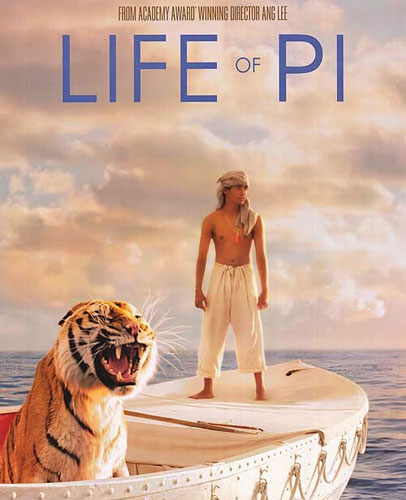
It is not hard to imagine why it took almost 10 years for someone to adapt Yann Martel’s Life of Pi into a motion picture. Replete with impossible scenarios and other-worldly imagery, the book was deemed “unfilmable” and it wasn’t until Ang Lee, the Taiwanese auteur, decided to come on board that the movie finally began to take shape. To make his vision come to life, Lee sought help of Rhythm & Hues, one of the world’s leading Visual Effects studios, and together they were successfully able to bring the beauty of the words come alive on celluloid and make a film that everyone has been raving about.
James Cameron on Ang Lee’s Life of Pi :

For Rhythm & Hues, the lead studio handling the visual effects on Life of Pi, the movie presented great challenges. Although the studio had worked on photo-realistic projects in the past, Life of Pi was a little more tricky as the movie required the presence of photo-realistic animals for almost the entire duration of the movie. Furthermore, the biggest challenge was to create Richard Parker, the Royal Bengal tiger that Pi finds himself stranded with in the middle of the ocean. Since the plot of the movie was driven by Pi’s interaction with Richard Parker, the tiger not only had to look real but had to come across as a living, breathing character. Apart from the tiger, Rhythm & Hues also created several other CG characters for the movie, which included a zebra, an orangutan, a whale, meerkats, Pi’s lifeboat and the various kinds of fishes seen in the movie. Besides these characters, the studio also had to create ocean surfaces, which were later blended with live action water.
This mammoth task was undertaken by the studio’s artists in Los Angeles, Mumbai, Hyderabad, Kuala Lumpur and Vancouver. It was truly a global effort and almost 40% of the visual effects work on the movie was done out of the Rhythm & Hues studios in Asia. Needless to say, working on Life of Pi was a great learning experience for everyone at Rhythm & Hues and it was a proud moment for all the artists to be involved in a movie that many critics are hailing as “the best movie of the year”.
Here are some more details of work done by different departments of Rhythm & Hues in Asia on Life of Pi:
Modeling:
The modeling department in India started work on Life of Pi right from the pre-production stage and were involved until the very end. The team in India worked on models of various CG characters present in the movie, including zebra, whales, orangutan, meerkat, lifeboat, shark, flying fishes, dolphins, the ecosystem as well as an extremely realistic digital double of Pi.There was a proper detailed study done for orangutans, whales, zebras and meerkats before they were modeled. Besides these models, the modeling department in India, along with the LA team, also worked on complex blendshapes for the tiger. A specific challenge for the modeling team in India was that the lifeboat model had to be modeled exactly as the real life boat as shots of real lifeboat were intercut with shots of the CG lifeboat. Hence, a lot of attention was given to detail, especially because numerous scenes involved extreme close-ups of the boat (for example, the nuts and bolts on the lifeboat were modeled with extreme precision).
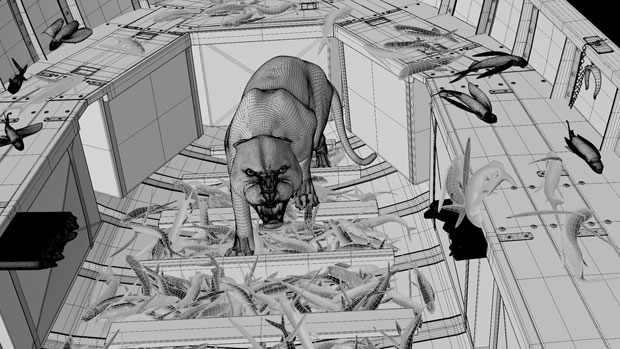
Zbrush, Maya and the studio’s own proprietary software were used to create these models. The zebra and meerkat models were sculpted in Zbrush during the preproduction stages. There was a lot of coordination with the art department to get the look and feel of the orangutan right.The team also bought a cast of meerkat skull to study the interior of its mouth.
R&H modeled a digital orangutan :
Texturing:
The texturing department in India worked on meerkats, lifeboat and other smaller props. There were photo-real variations of meerkats created as the meerkat island had to be populated with thousands of meerkats.
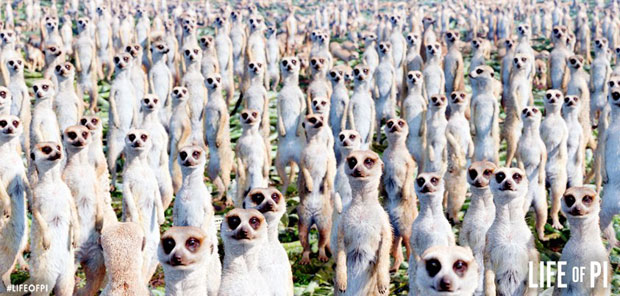
The lifeboat was also textured in India, and as was the case for modeling, the boat required very detailed textures. Furthermore, different variations of the lifeboat’s textures were created because as the movie progressed, the textures on the boat changed from having a clean look to having a more worn out and beaten look.
The most challenging part was to match the reference pictures, which had minute details.
Stereo QC:
Being a 3D movie, Life of Pi was shot with 2 different cameras. As a result, there were two different background footages, one for the left eye and the other for the right eye. The Stereo QC department had to deal with the color and orientation differences between both left and right footages. While shooting, it is not uncommon to have some shots with differences in color and orientation between the two footages (this is called stereo buzz) and hence, the Stereo QC department was in charge of fixing these issues so that no such artifacts are seen when watching the movie in 3D. So, Stereo QC would match the color of one footage to the color of another footage. Additionally, for a shot to be perfect in stereo, both the left and right cameras need to output exactly the same image with a little offset only in the x direction. In case of any alignment mismatch, the shot was fixed by the Stereo QC department.
A breakdown of Pi on the lifeboat with the zebra :

More importantly, Stereo QC was the first department in the production pipeline and hence, the department had to make sure that there weren’t any artifacts left in any of the shots before they were passed down to other departments in the pipeline.
BgPrep/Roto:
The BgPrep/Roto department work involved a lot of clean-up (BgPrep) for the tank area, intensive rotos for set extensions and character integration, clean up of wire, markers and other props which were used during the shoot. The real challenge was to make it look flawless in 3D (stereo), as every pixel makes a huge difference when one is dealing with stereo projects. The difficulty level of few of the tasks was so high that it took more than 4 weeks with multiple artists to finish each one of them. The number of rotos done for Pi’s hair and other minute details was staggering.
Tracking:
![]()
The tracking department had to incorporate a lot of changes in their usual workflow to tackle the complexity of the shots. The department were at times dealing with four cameras, two from the main stereo shot (left and right) and two witness cameras for the same shot. The challenge was to match the camera consistently across all the available plates so as to get the most accurate camera track possible. Since it was a stereo project, the department had to match the convergence correctly to the plate so that when the CG element is composited on top of the tracked footage, the CG element appears to be at the correct depth. Lifeboat matchmove played a important role as it not only helped the animation department to place the tiger correctly in world space but also helped the water FX department to generate the first pass on waves. The department developed some new tools in camera tracking for this show, and with the help of these new tools, the department was able to achieve far better results. Post enhancement was done to accentuate the look and feel of the shot, such as the the tooth fruit shot on the mystical meerkat island. There were some complex full body matchmove shots done to enhance Pi’s look in the flying fish sequence as well. Certain shots where Pi had to directly interact with the tiger, for example when he keeps tiger’s head on his lap, were challenging matchmove tasks since the integration had to be seamless and as realistic as possible. Water, being organic in its nature, has its own obstacles, and since the department couldn’t track 2D points directly on the water surface, trackers had to rely on witness footages to get accurate foreground track. The frame ranges on this show were longer than average and the department had roughly 550 shots to track as a team.
Animation:
The animation team in India got an opportunity to work on a couple of sequences with multiple characters. The biggest challenge for animators was to get the performance right for Richard Parker, and to make it look believable and realistic, especially in the sequence where Pi is trying to tame the tiger, as it had both CG and live action tiger. So, the animators had to make sure that the CG tiger was at par with the real one. For the flying fish sequence, a lot of elements had to be taken into consideration so that the interaction between Pi, the fishes and the tiger worked well. Working on the meerkat island sequence was a lot of fun as the animators had to choreograph multiple meerkats in almost every single shot, particularly when they are crawling all over Pi’s body. Overall the show was a great learning experience from an animator’s point of view and gave them the opportunity to have an in depth study of a tiger’s personality and behavior, as well as those of other animals.
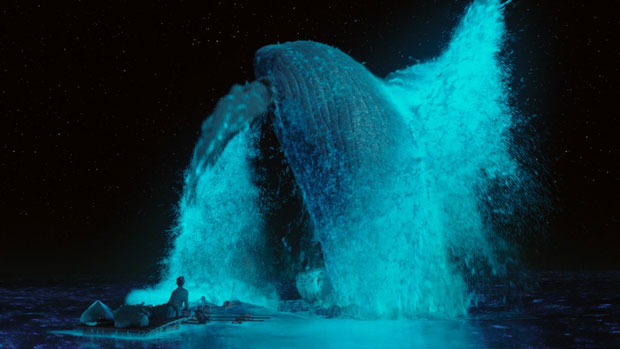
It would have been impossible to achieve such a level of detail without the guidance of the movie’s animation director, Erik de Boer. Erik spent a lot of time on the sets and he would constantly provide the team feedback regarding the look and feel of the animated characters. This was especially true in the case of the hyena and the meerkats. Since the look and feel of these characters were paramount, Erik would provide the team with a lot of reference and feedback in terms of how the characters should behave and what the director was expecting out of a particular scene/sequence. Besides being realistic, the animals needed to have the characteristics that Ang Lee was looking for and since Erik was present on the set, he could have a direct conversation with Ang and show him the progress of the shots first-hand. Another interesting shot that the department handled was the whale sequence. Though the shot had to be realistic, it had a certain fantastical element to it and balancing reality with the right dose of fantasy was quite an exciting task for the animators. Small details had to be looked into – for example, how high could the whale jump. It was a tight rope to walk and discussions almost always centered around how much could the animators exaggerate the movement of the whale to lend it a fantastical yet believable look and feel.
Technical Animation:
The Technical Animation (Tech Anim) on Life of Pi was aesthetically and technically more challenging as compared to the previous shows the studio had done before. What made the project really challenging was the task of making the CG tiger look as real as possible so that it would match with the real tiger.The work mostly involved simulating muscle harmonics, skin slide and collisions as well as simulating the guides and cleaning up the fur on tiger and other CG characters. Additional work involved adding wind effects on fur and matching the fur with environment, Pi’s interaction with the tiger, tiger’s interaction with the tarp and other parts of the boat. The department also worked on meerkats, flying fish, boat and the tarp.
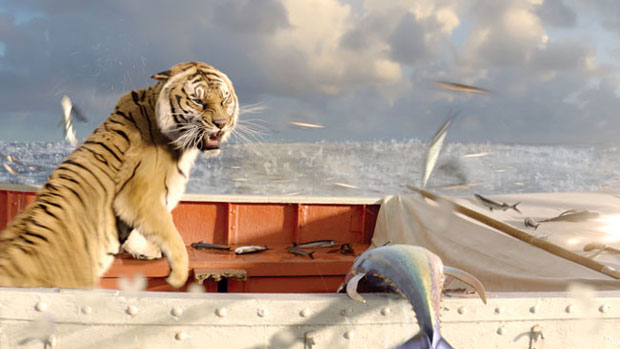
Watch the flying fish sequence:
FX:
The FX department in India worked on whitecaps, foam and churn elements for the ocean surface. The team also worked on interactive splashes and bubbles for the lifeboat and raft, detritus, bio-luminescence and schools of fish. These effects were achieved using a vast array of in-house tools, ranging from particles and volumes to elaborate shader setups. The most challenging aspect of all the ocean work was achieving integration of these elements with the ocean at varying levels of turbulence and roughness. Character related effects included the creation of drool strands for Richard Parker along with other interactive elements such as footprints, dust and debris.

FX Light:
The FX-lighters were responsible for creating the ocean surfaces on Life of Pi. This involved setting up the basic ocean surface for the shot and dial it in so it had the appropriate movement, scale and emotion. Work involved the overall look and topology of the surfaces and tackling how the water feels/behaves in motion: how stormy or calm it would be, what the water’s “emotional responses” would be. The department also had the responsibility of integrating and lighting the FX elements into the scene (foam, whitecaps etc).
As the properties of water is all about reflections and refractions the fx light dept had to heavily depend on the sky for lighting up cg water.
The main challenge while creating water was when the artists had to retain plate water in the foreground, while extending the rest of the scene with CG water all the way to the horizon. The artists had to accurately match the timing and size of each and every wave so that it merges seamlessly with real water.
Environment:

The Environment department was responsible for the creation of carnivorous island inhabited by meerkats. This was the first time that a huge CG environment was created at R&H and the sequence had its own inherent complications. Some of the shots were full CG, hence everything had to be created from scratch. The shot presented two types of challenges: 1) how to render a huge island made of tangled roots and trees (there was no ground) and how to make the island look believable, and 2) how to best portray the millions of meerkats’ interaction with the ground.
A breakdown of the meerkats sequence:

Lighting:
As the lookdev, matchmove and animation were done with an amazing sense of precision, getting the tiger to look realistic was not a problem, the challenge, however, was to make him fit well in the environment. The shots were setup to make sure that the tiger’s movement on the boat also affected the lighting on the tiger and account for the slightest lighting changes on the boat. The renders had to account for any possible light bouncing off the tiger. For example, in the sequence where young Pi is trying to feed the tiger, the tiger moves through pools of light towards
